This article was written in 2010. Since then, McCall’s is no longer in business, so I have deleted out-of-date links and info and left the rest.
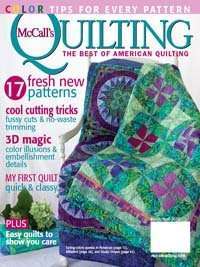
Do you have the March-April Issue of McCall’s Quilting (2010)? As usual, it is full of inspiration for Inklingo quilters.
When Inklingoist Tilde Binger in Copenhagen received her copy in the mail, she immediately identified several patterns that use Inklingo shapes, and she wrote to the Inklingo group about it.
Adapting a Pattern for Inklingo
It is easy “to inklingo” any pattern that uses the same shapes and sizes. These tips will point you in the right direction. Issues of McCall’s usually include several Inklingoable designs.
The designers have used wonderful color palettes and the photography is great. Not only that, but there is often more info on McCall’s website for each quilt, and KITS are offered so you can make the quilts with the fabrics in the photos. How cool is that?
Colonial Star
(pages 30-32)
The eight-pointed stars in this quilt are commonly called Sawtooth Stars or Evening Stars. They are made with Flying Geese.
Inklingo Flying Geese blocks require less fabric than the method in the magazine. The yardage is easy to calculate using the magazine, the suggested cutting layouts in the Inklingo Catalogue of Shapes, and Monkey’s Cheat Sheet.
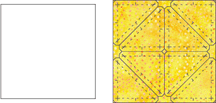
1. Cut one square (unprinted, 4.75 in); print 8 triangles (1.75 in HST, 5.75 x 6); and cut into squares for each set of 4 Flying Geese. (Dimensions are provided in the Inklingo Catalogue of Shapes for HST in every Inklingo collection, so you don’t have to do any math.)
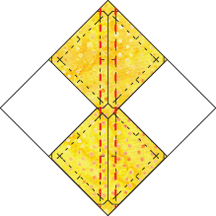
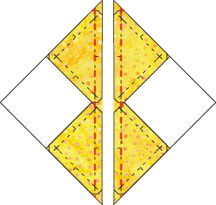
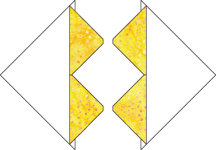

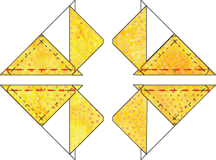
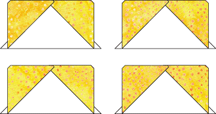
Flying Geese with Inklingo
There is a video for Flying Geese on this page.
There are many advantages to this method. No measuring, no drawing lines on the fabric, no weird rulers, no paper to pick off, and no waste! Flying Geese blocks with Inklingo are faster and more precise than any other method.
The Inklingo method makes 4 identical Flying Geese units at a time, and that is exactly what you need for each star in this quilt. There are detailed, illustrated instructions in The Inklingo Handbook (pages 66-67), and in the Inklingo Triangle Tips (free PDF under the Machine Piecing tab on the website).
This pattern also uses 1.75-inch HST (half square triangles) in Sawtooth Squares and 3.5-inch Inklingo QST (quarter square triangles). See the Triangle Tips PDF for illustrated instructions for those too.
Chimayo Dinner Party
(pages 48-51)
This is a Dresden Plate design in great contemporary fabrics.
With Inklingo, you can skip all of the tracing and templates and use the Inklingo Dresden Plate Appliqué Shape Collection PDF. It includes blades with folded points and several other blades to mix and match.
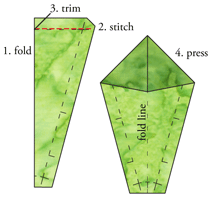
The instructions for folded blades are in the Dresden Plate Design Book—74 pages, also FREE from Inklingo!
Notice that the blocks in the magazine finish at 10 inches. You can use the Inklingo folded blades on a 10-inch background (11 inches unfinished).
However, if you print the backgrounds with Inklingo (optional), the blocks finish at 9 inches. If want your quilt to be exactly the same size as the one in the magazine, you will need to add a row of blocks on one side and the bottom edge. That means making more blocks, but if you do, the quilt will have an odd number of rows in each direction, so the corners can match if you prefer a symmetrical layout.
The Inklingo Dresden Plate Applique Collection includes everything you need. Order and download the Dresden Plate Design Book first, to see complete instructions. Consider using the other blades too.
Cubism
(pages 52-54)
This is a creative diamond design with wonderful use of color that is characteristic of Karen Combs.
The magazine includes a template for a 2-inch 60-degree diamond. Inklingoists skip the tracing and the templates, and print the diamonds on the back of the fabric with Inklingo instead! No templates, no tracing, no measuring!

The yardage requirements are the same (or less) with Inklingo, and you have a choice of four layouts to print on the fabric, depending on where you want the straight grain.
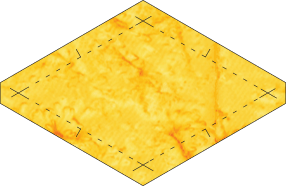
The cutting lines, stitching lines, crosshairs, and matching marks will make it a breeze to assemble this quilt—so you will be ready to start a new one sooner.
Other quilts in this issue use Inklingo shapes, but this should give you a good start.
Inklingo Resources
- The Index of Shapes (under the Support tab at Inklingo.com)
- The Catalogue of Shapes in each collection (yardage requirements, cutting layouts, etc.)
- Monkey’s Cheat Sheet (under the Support tab at Inklingo.com)
- Triangle Tips PDF
- The Inklingo Handbook (The first chapter, Printing with Inklingo, is free.)
If you have not tried Inklingo yet, you can get started in the next few minutes with the free shape collection.
Some day, we hope all magazines will include references to Inklingo methods. In the meantime, refer to The Inklingo Handbook and the wealth of information on the Inklingo website, and jot the numbers down on Monkey’s Cheat Sheet.
Linda & Monkey
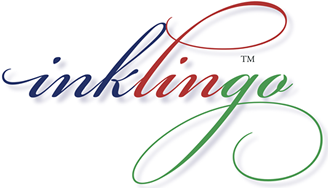


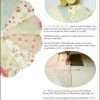
Thanks Linda, this is wonderful information to have on hand.
You ladies are amazing. I have all the INKLINGO’S. I am up in NY visiting my brother, but as soon as I get home I will be starting the Cubism quilt. The magazine should be there.
Thanks Tilde.
Hugs,
Frummie
Wow, it’s amazing how you can Inklingo-ize so many patterns. Of course that means we need to get all the collections! LOL
Thanks for the head’s up to Tilde and Monkey too.